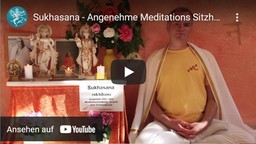

Sukhasana
«Sukhasana», one of the Meditation Postures; Cross-Legged; Pleasant Meditation Position. «Sukhasana» consists of two words: «Sukha» means Joy, pleasant, easy. «Asana» means Position. Thus «Sukhasana» is the Pleasant Position and refers to the Meditation Posture, in English as a «Cross-Legged Seat» is referred to. In relation to «Padmasana», «Siddhasana» and «Swastikasana» the «Sukhasana» is easy.
Table of Contents
1 Sukadev about Sukhasana
2 Swami Sivananda about Sukhasana
2.1 Method
2.2 Variationen
2.3 Benefits of Padma, Siddha and Swastika Asana
Sukadev about Sukhasana

 |
 |
Swami Sivananda about Sukhasana
Each easy and comfortable Posture for «Japa» (Reciting of Mantras) and Meditation is the Sukhasana Posture. The important point here is that the head, neck and trunk are in line, without any curve. People who start «Japa» (Reciting Mantras) when they are 30 or 40 years old will usually not be able to sit in «Padmasana», «Siddhasana» or «Swastikasana» for a longtime. I will now go on to describe a possible form of «Sukhasana» where older people can sit and meditate for a long time. These is particularly suitable for elderly people, who, despite repeated attempts, are unable to sit in «Padmasana» or «Siddhasana».
Method
Take a bed sheet of about 1.80 length. Fold it lengthways to a width of about 20 cm. Sit in the familiar way, feet are below the thighs. Raise the two knees to chest level until you are between the knees a distance of 20 - 25 cm. Now take the folded sheet. One End keeping you close to the left knee; while you go back with the left side, touch the right knee, come to the starting point and knot the two ends together. This Asana supports hands, legs and back. That's why you will not tire. If it is not possible for you to take another Asana, then at least sit in this Asana for a long time, practice «Japa» and meditate.
Variations
I. Pavanamuktasana: Sit on the floor, hold your heels together and raise your knees to chest level. Grasp your knees with both hands.
II. Vama Pavanamuktasana: In this Posture, only the right knee is lifted off the ground. It is grasped with both hands as in «Pavanmuktasana».
III. Dakshina Pavanamuktasana: In this Asana, the right knee is raised and grasped with the hands and the left leg remains on the floor.
The three named Asanas can be executed while you are lying on the ground.
IV. Bhairavasana: Sit in «Vama Pavanamuktasana». Instead of grasping the knees with your hands, keep your hands near the sides of your thighs.
Benefits of Padma, Siddha and Swastika Asana
Books about Hatha Yoga highly praise the virtues and advantages of «Padmasana» and «Siddhasana». Those who sit in this Asana for at least 15 minutes each day with their eyes closed, focusing on the divine in the Lotus of the Heart, will find all the sins destroyed and attain quickly the «Moksha» (liberation).
These Asanas heat the digestive fire and have a positive effect on appetite, health and the feeling of being happy. These eliminate rheumatism and keep the three humors, wind, bile and mucus in reasonable proportion. These purify and strengthen the nerves in the leg and thigh area. These are very capable to beware the Brahmacharya (literally the life in the Absolute).

